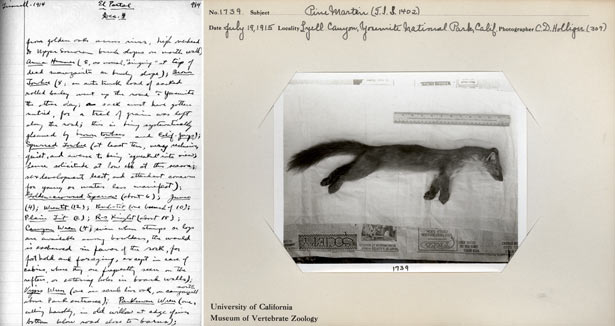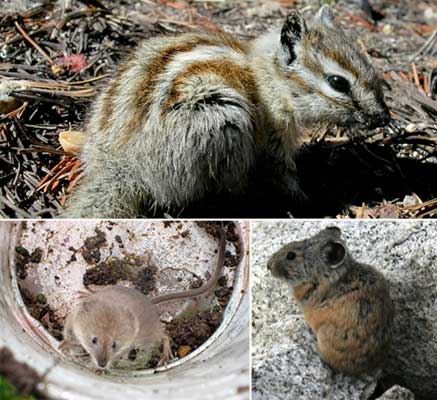 The original Yosemite transect survey was conducted by Berkeley zoologist Joseph Grinnell in the second decade of the 20th century. He and his colleagues collected diverse Sierran species, like the pine marten at right, making detailed observations (left) about them that continue to impress scientists as ‘amazingly perceptive.’
The original Yosemite transect survey was conducted by Berkeley zoologist Joseph Grinnell in the second decade of the 20th century. He and his colleagues collected diverse Sierran species, like the pine marten at right, making detailed observations (left) about them that continue to impress scientists as ‘amazingly perceptive.’Warming in Yosemite sends small mammals packing to higher, cooler elevations
Resurvey of Grinnell’s famed transect through the park shows ‘what has changed and why.’ Climate is part of the answer
| 22 October 2008
BERKELEY — Global warming is causing major shifts in the range of small mammals in Yosemite National Park, according to a new study by Berkeley biologists.
The study, published earlier this month in Science, compared small-mammal populations in the park today versus 90 years ago and found that mammals like shrews, mice, and ground squirrels have moved to higher elevations or reduced their ranges in response to warmer temperatures, essentially shuffling the species living together in any one spot.
“We didn’t set out to study the effects of climate change, but to see what has changed and why” since the last full-scale survey in Yosemite in 1918, says study leader Craig Moritz, professor of integrative biology and director of Berkeley’s Museum of Vertebrate Zoology. “But the most dramatic finding in the Yosemite transect was the upward elevational shift of species. When we asked ourselves, ‘What changed?’ it hit us between the eyes: the climate.”
The central Sierra Nevada has seen a general warming, Moritz notes, evidenced not only by a 3-degree Celsius increase in nighttime low temperatures, but also the receding of glaciers — Lyell Glacier is half the size it was 100 years ago — and an increase in precipitation as rain instead of snow.
While the population movements have not altered biodiversity in the park, Berkeley biologists say rapid changes in less than a century could be a problem. Although half the species shifted their ranges, the other half did not, which means communities have been altered and the species interacting with one another have changed.
“These kinds of changes in community composition have been going on forever,” says co-author James Patton, a Berkeley professor emeritus of integrative biology who led the field work in Yosemite. “The only thing that makes this different is that it has probably happened in our lifetime. It is the speed with which these changes are taking place that gives one pause.”
According to Patton, if species movement is slow, there is enough time for the community structure to equilibrate with each “turnover event.” However, “if change happens too fast,” he says, “elements of the system may start to collapse because a keystone element of that system gets pulled out too quickly. That is something we just don’t know. From my standpoint, if I had the opportunity, I would want to minimize the rate of change.”
This finding highlights the need for protected areas, such as national parks, in which species can move in response to changes in the environment.
“Yosemite has been very well-managed so that species have been allowed to move,” says Moritz, who is working with state officials to develop conservation strategies targeted to species that are sensitive to climate change. “We need to continue to protect large swatches of public land from land-use changes.”
The foundation for the current study is a landmark survey of Sierra Nevada birds, mammals, reptiles, and amphibians initiated early last century by Joseph Grinnell, founding director of the museum and a zoology professor at Berkeley. With a large number of colleagues and students, Grinnell traipsed through the Sierra Nevada — from the Modoc Plateau in the north to the San Jacinto range in the south — collecting specimens and recording for posterity the variety of life then under threat from gold mining and overgrazing.
Moritz proposed resurveying all the sites visited by Grinnell and his colleagues, starting with the Yosemite transect originally surveyed from 1914 to 1920, which stretched from the San Joaquin Valley through the park and over the Sierra crest to Mono Lake. With funding from the National Science Foundation, the Yosemite Foundation, and the National Park Service, the Grinnell Resurvey Project commenced in 2003. This month’s Science paper is the first result, appearing on the 100th anniversary of the founding of the museum in 1908.
 Some of Yosemite’s small mammals have shifted their established habitat ranges since the initial Grinnell Survey 90 years ago. The pika (above right) is among those that have moved to higher elevations as a result of warmer temperatures in the central Sierra Nevada; others, such as the alpine chipmunk (top), have stayed in place but seen their range diminish for the same reason. The montane shrew, seen here (above left) peering out after its capture in the park’s backcountry, belongs to a population that has recolonized Yosemite Valley from higher elevations as valley meadows have returned to the wetter conditions that preceded human occupation.
Some of Yosemite’s small mammals have shifted their established habitat ranges since the initial Grinnell Survey 90 years ago. The pika (above right) is among those that have moved to higher elevations as a result of warmer temperatures in the central Sierra Nevada; others, such as the alpine chipmunk (top), have stayed in place but seen their range diminish for the same reason. The montane shrew, seen here (above left) peering out after its capture in the park’s backcountry, belongs to a population that has recolonized Yosemite Valley from higher elevations as valley meadows have returned to the wetter conditions that preceded human occupation.Patton led the resurvey of the Yosemite transect from 2003 through 2005 and, at the behest of park rangers, surveyed the rest of the park’s small mammals in 2006 and 2007 as a baseline for future surveys. The current study involves data from the transect only, obtained at 40 of Grinnell’s collection sites and far from the crowded campsites and hotels of Yosemite Valley and Tuolumne Meadows. The field notes by Grinnell and his crew were invaluable, Patton says.
“The impressive thing about these guys — not just Grinnell, but people like Charles Camp, who was an undergraduate at the time — is what incredibly observant natural historians they were, and the detail with which they recorded everything,” says Patton, who found passages in the notebooks about the then-novel concept of the “ecological niche” several years before Grinnell published his first papers on it. “In poring over these notebooks, I keep pulling out tidbits that are amazingly perceptive. These guys were out there thinking about what they were seeing and what it meant in a larger context long before most other people were doing that.”
Thanks to these detailed field notes recording not only when, where, and what they saw and trapped but also what they failed to observe, the Berkeley biologists were able to perform a statistical analysis that makes the study results very solid, says co-author and conservation biologist Steve Beissinger, professor of environmental science, policy, and management.
“One of the biggest problems we have when comparing the distribution of species now and in the past is false absences. If they didn’t see something back then, is it because it wasn’t there, or because it just wasn’t detected?” he says. Employing occupancy models developed in the past few years, he added, “the Grinnell group’s data allows us to go back and, night by night, reconstruct their trapping success for small mammals and develop a probability for detecting each species for Grinnell and for us. This is one of the first studies to use the model to look at climate change and historic changes in range.”
The researchers found that, of the 28 small mammals observed in the transect, half had expanded their range upward by more than 500 meters, or 1,600 feet. While low-elevation species such as the California vole (Microtus californicus) and the California pocket mouse (Chaetodipus californicus) increased their range by moving upslope, high-elevation species such as the bushy-tailed woodrat (Neotoma cinerea) and Allen’s chipmunk (Tamias senex) generally decreased their range. Short-lived, fast-breeding species were more likely to expand their ranges than were their long-lived, less fecund relatives, Moritz says.
For the alpine chipmunk (Tamias alpinus), upward movement has caused its range to shrink and possibly put the chipmunk, one of California’s few endemic mammals, at risk of extinction. Although 90 years ago the chipmunk was common on granite slabs in lodgepole-pine forests below 7,800 feet, Patton was unable to find any below 9,600 to 9,800 feet, an upward movement of 2,000 feet.
“It used to be very common at Tuolumne Meadows; now you have to get up to treeline to find it,” Patton says.
Similarly, on the eastern slopes of the Sierra, the one-ounce pinyon mouse (Peromyscus truei), has moved entirely out of the pinyon pine/juniper belt into a very different habitat, the montane forest dominated by whitebark pine. “Its preferences were more catholic than we suspected,” Moritz says.
While higher-elevation shifts were driven primarily by climate, Patton noted that lower-elevation changes probably had something to do with land-use changes. A third mammal impacted significantly in the past 90 years is the Trowbridge shrew (Sorex trowbridgii), which used to be the only shrew in Yosemite Valley. Today, with the departure of Indians who regularly burned the valley, the valley is wetter, and the Trowbridge shrew has been totally replaced by the montane shrew (Sorex monticolus), which moved downslope to recolonize the valley.
The Berkeley team, with the assistance of colleagues around the state, is continuing its resurvey of Grinnell’s transects and will eventually resurvey coastal mountains as well. This work will provide information about northward or southward movement of animals in addition to elevational movement in response to climate and land use change. One of the key missing pieces, however, is how fast this change has taken place.
“We have two surveys 90 years apart, which doesn’t give you a rate,” Patton says. “This change could have happened decades ago, or last year. We don’t know.”

